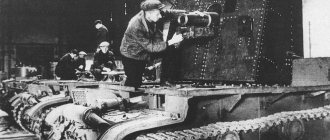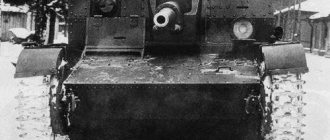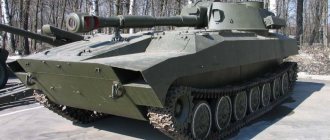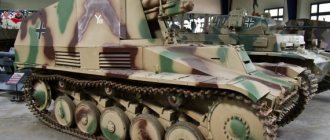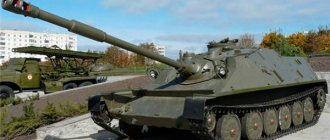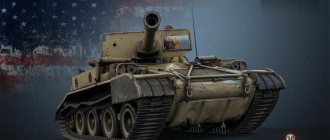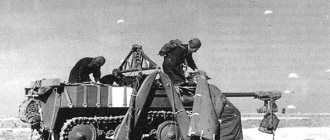Large-caliber howitzers are one of the most common types of artillery in our time. Having demonstrated their power back during the First World War, they are not going to leave the stage. Although towed artillery is still used, self-propelled artillery mounts are used to achieve maximum mobility and maneuverability of troops.
The latest Russian development in this area is the 2S53 “Coalition”, armed with a 152mm howitzer. If it can be put into service in a timely manner, it will provide the Russian army with a certain superiority in the field of artillery.
History of creation
Starting from the 70s, the 152mm towed howitzers available in the divisional artillery of the Soviet Army began to be replaced with 2S3 Akatsiya self-propelled guns. It was a fighting vehicle typical of the “Soviet school” - simple, inexpensive, and, as they sometimes say, “soldier-resistant.” At the same time, in terms of combat qualities, it was at least no worse than its competitors.
But within a few years, the development of a new, promising howitzer for the divisional level began. Its self-propelled version, the 2S19 Msta-S, went into mass production in 1988. The new self-propelled gun differed from the Akatsiya in its higher firing range, increased rate of fire, and expanded range of ammunition.
Thus, the Russian army turned out to be the owner of not just modern, but even advanced self-propelled guns in terms of characteristics.
It would seem that replacing Msta will not be needed for a long time. However, NATO countries reviewed and adopted the “Joint Memorandum of Understanding on Ballistics” in the early 1990s. As part of the memorandum, it was planned to develop a 155mm howitzer with a barrel length of 52 calibers and an increased volume of the charging chamber.
Such a prospect could not only reduce the advantages of the Msta - it would turn the Russian self-propelled gun from the forefront to the laggard. In addition, demonstrations of the 2S19 at international exhibitions revealed that potential customers consider the self-propelled gun’s rate of fire to be insufficient and the fire control system to be outdated.
In parallel with the modernization of the self-propelled guns, the development of a new, more advanced artillery system began. This work was carried out under the code “Coalition”. Initially, it was planned to ensure a high rate of fire through the use of a double-barreled gun, but then due to low reliability and high cost, this scheme was abandoned. For the first time, the new self-propelled gun - 2S35 "Coalition-SV" was demonstrated to the public at the 2014 Victory Parade.
"Hello" from NATO
General Director of Uraltransmash Dmitry Semizorov noted the great interest in the world in the new product of the Ural gunsmiths. And few people know that the developers had to go through a difficult path when creating it.
It seems that the emergence of such a high-tech self-propelled gun is a natural process. However, the decision to develop it at one time was not made without heated debate. After all, when in 1989 the 152-mm self-propelled howitzer 2S19 “Msta-S” was adopted by the Soviet Army, it was considered that this was the groundwork for several decades to come. Quite justifiably - the howitzer’s characteristics were ahead of the analogues of self-propelled guns available in foreign armies.
But only four years passed, and then an alarming “bell” came from NATO - they adopted the “Joint Memorandum of Understanding on Ballistics.” This document defined the basic directions for the development of artillery in Western countries in the 21st century, including for 155-mm howitzers.
The document provided very specific guidelines: the maximum firing range was required to be increased to 30 km when firing high-explosive fragmentation shells and to 40 km when firing active-rocket shells. For our self-propelled artillery unit (SAU) 2S19 “Msta-S” these indicators were 25 and 29 km, respectively. Undershoot…
It was decided to carry out modernization, and in the future - to develop a new artillery system with the necessary advanced tactical and technical characteristics.
© uraltransmash.com
Design
The chassis for the prototypes of the Coalition self-propelled guns served as the body of the serial Msta. When the adoption of a 2-barrel self-propelled gun was expected, there were reports in the media that its chassis would be unified with the T-95 tank (which never appeared). As a result, the 2S35 self-propelled howitzer was built on the chassis of the T-90 tank (probably with lightweight frontal armor).
At the same time, the armored volume of the hull has been completely redesigned. The crew is located like in a T-14 tank - inside an armored compartment in the front of the vehicle, the commander and gunner are on either side of the driver. The turret and fighting compartment in the Coalition building are automated and uninhabited.
In addition to the gun, ammunition and automatic loader mechanisms, the 2S35 turret contains fire control system equipment and an auxiliary power unit (APU).
It is possible that the same APU was used as on the Msta - the AP-18 gas turbine. At the rear of the Coalition there is an engine compartment with a V-92S2 engine, similar to that installed on the T-90 tank. With a working volume of 38.8 liters, the diesel self-propelled gun develops a power of 1000 hp. Probably, the fuel tanks installed on the T-90 in the front part, occupied by the crew on the self-propelled gun, were also moved closer to the stern. A traditional log for self-pulling is suspended on the Coalition’s stern sheet.
Navigation, target selection and guidance of the 2S35 are carried out using a single information target, the data of which is displayed on the multifunctional displays of the commander and gunner. The possibility of integrating the “Coalition” into the digital management system of the ESU TK has been implemented.
The self-propelled gun is armed with a 155mm 2A88 gun. The barrel length of this rifled howitzer has been increased to 52 calibers versus 47 calibers for the 2A64 howitzer, which was equipped with the Msta-S self-propelled guns. The uninhabited tower made it possible to increase the ammunition load of the 2S35 from 50 to 70 rounds. A pneumatic automatic loader allows you to send shells and charges into the chamber at any elevation angle, providing a high rate of fire - because no time is wasted returning the gun to the loading line (and back).
To automate the process of setting the required charge, the designers abandoned the cartridges, and the Coalition uses cap loading. It was stated that the charge was ignited by a microwave system. This should ensure simultaneous combustion of gunpowder and, as a result, better ballistics.
Due to the measures taken, the maximum firing range of the Coalition has increased to 70 kilometers - so far it remains a record. However, this is still the declared range when firing special projectiles with satellite guidance.
If the 2S35 uses conventional shells, it can hit targets at a distance of up to 40 km - which also exceeds the capabilities of its analogues.
It was announced that new guided projectiles would be created for the 2S35 self-propelled guns, but there is no specific information about them. It is safe to say that the Coalition can use the entire existing range of ammunition for 152mm howitzers. Let us recall that the main high-explosive fragmentation projectile of this caliber, 3OF64, has a mass of 43.5 kg and is loaded with 7.8 kg of hexal. Cluster shells 3O13 contain eight fragmentation warheads containing 230 grams of hexal, and 3O23 - 40 cumulative submunitions.
The existing laser-guided Krasnopol projectile can be used as a precision-guided munition. The self-propelled gun can also use special-purpose shells - 3RB30 jammers; it has been reported that smoke shells filled with white phosphorus have been created. The ammunition of the Coalition self-propelled gun can be replenished using a transport loading vehicle on the chassis of a four-axle KamAZ-6350 truck.
It takes no more than one and a half minutes to prepare the vehicle, and it can completely reload its ammunition load in 20 minutes. All operations are mechanized.
The auxiliary armament of the 2S35 self-propelled gun is represented by a remote-controlled machine gun mounted on the roof of the turret. A 12.7mm KORD machine gun is mounted in it; the capacity of the machine gun belt in the box is 200 rounds. Additional cartridge boxes are also transported in the transport-loading vehicle. The machine gun is aimed using television cameras in the installation, and a laser rangefinder is used to determine the distance. Smoke grenade launchers mounted on the sides of the self-propelled gun turret are used to set up camouflage screens.
"Fire attack with one gun." The Coalition-SV complex has surpassed world analogues
It is the newest generation of self-propelled guns and, in its main tactical and technical characteristics - rate of fire, range, shooting accuracy - is superior to modern domestic and foreign analogues.
The basis of its firepower is a 152 mm cannon with a firing rate of more than ten rounds per minute, which is higher than other artillery systems. One of the main features of the Coalition is the ability to remotely control firing, the accuracy of which is ensured by an automated control system for the processes of weapon pointing, target selection and navigation. ' TASS/Russian Ministry of Defense/UVZ Press Service'
The complex was created in cooperation between Rostec enterprises that are part of the Uralvagonzavod concern. Its developer is the Central Research Institute (CSRI) "Burevestnik" (Uraltransmash).
About this theme
Burevestnik specialists very highly appreciate the potential of the Coalition: the created 152-mm artillery unified module in the future can not only be used as the basis for the development of combat vehicles on various chassis for the needs of the Ground Forces and coastal defense, but also installed on ships of the Navy fleet. - calls this product “the first step towards robotic Russian ground military equipment.”
Also, the “Coalition-SV”, under the control of on-board equipment, provides a “fire raid with one gun” mode. Previously, a similar firing mode was used on the 2S19M2 “Msta-S” self-propelled howitzer, which was accepted for supply to the Russian army in 2014, and during this time it has established itself as a reliable and effective artillery product.
Modifications
A wheeled version of the self-propelled gun is under development, designated 2S35-1 “Coalition SV-KSh”. It differs from the main modification in that the uninhabited turret is mounted not on a tank chassis, but on a KamAZ-6560 truck, originally designed to accommodate anti-aircraft guns.
It was planned to put it into service simultaneously with the tracked Coalition, but there is still no information about the wheeled self-propelled gun.
Traditionally, self-propelled guns on a wheeled chassis have been used either by countries with a developed road network, or by those where such a design provides better mobility (for example, South Africa). It is likely that the wheeled “Coalition” will become the base for the announced coastal artillery complex, armed with the 2A88 howitzer.
It was believed that a pre-production batch of the 2S35 self-propelled guns was shown at the 2014 parade, and in the future the Coalition will use the chassis of the Armata platform. After the announcement that the production of "Armata" will be limited to the pilot batch, such a prospect looks doubtful.
It all started with "Uninhabitable"
The 2S35 “Coalition-SV” was officially presented at the Victory Parade on May 9, 2015, but the idea of creating a rapid-firing automated self-propelled artillery gun (SAO) for divisional-army units of the Ground Forces dates back to the early 1990s.
Artillery complex "Coalition-SV" during the dress rehearsal of the Victory Parade on Red Square, May 7, 2015
© Stanislav Krasilnikov/TASS
“By this time, the Soviet army was already armed with self-propelled guns of 152 mm caliber - Akatsiya, Giatsint-S and Msta-S. It was a powerful artillery weapon, but its tactical and technical characteristics did not allow it to compete in the future with foreign 155 mm guns, which were created in the USA - Crusader CAO (AFAS program), in Germany - PzH 2000, in Great Britain - AS90, in Korea - K9 and so on,” Pavel Kovalev, head of the Research and Design Department, said in an interview with TASS. Russian gunsmiths were faced with the task of finding ways to achieve superiority of domestic artillery over foreign ones.
According to the designer, in the mid-1990s, the enterprise carried out research work (R&D) “Uninhabitability”, during which it was possible to prove the possibility of building self-propelled artillery systems based on uninhabited, highly automated (and in the future, robotic) remotely controlled modules.
Head of Research and Development Pavel Kovalev
© Press service of the Central Research Institute "Burevestnik"
“Subsequently, this approach was implemented in the creation by our institute of uninhabited modules of various calibers, ranging from machine guns to cannons,” he says. — Due to socio-economic reasons, we managed to return to the study of technical ways to create a promising 152 mm caliber system, capable of raising the combat capabilities of divisional-army artillery to a new level, only in the early 2000s, in the Coalition research project.
This work also substantiated the feasibility of developing artillery based on complexes for interservice use, when a full-function artillery module becomes a unified basis for creating a line of combat vehicles on various chassis in the interests of different types of Armed Forces and branches of the military, for example, Ground Forces and Coastal Defense Forces. This probably explains the name “Coalition” given to the promising complex by the Main Missile and Artillery Directorate of the Russian Ministry of Defense, the customer of the gun.
Pavel Kovalev
Head of Research and Development
The enterprise developed, manufactured and tested an experimental prototype of a promising self-propelled gun, which confirmed the feasibility of the specified tactical and technical characteristics. “The results of the research allowed us to open the Coalition-SV development work in 2006 to create a promising 152-mm interspecific artillery system,” says the designer. — The high level of requirements presented by the customer, primarily in terms of rate of fire, predetermined the need to create a promising self-propelled gun according to the scheme with a double-barreled artillery unit. A prototype of such a self-propelled gun was manufactured and tested at the first stage of development work (R&D).”
Artillery complex "Coalition-SV" in the workshop
© Press service of Uraltransmash
In 2010, the customer radically changed its position, and the developers were given the task of creating, based on a single-barrel artillery unit, the Coalition complex, including a self-propelled gun on a tracked chassis, on a wheeled chassis and a wheeled transport-loading vehicle (TZM). This task was implemented in subsequent years by Burevestnik in cooperation with almost 30 leading enterprises in the industry.
However, the self-propelled gun, presented for the first time in 2015, was tested and refined for quite a long time, despite the fact that the external design of the vehicle did not change much. By May 9, 2015, Uraltransmash produced the first batch of self-propelled howitzers according to the design documentation. Since then, the self-propelled guns have remained virtually unchanged in appearance. The chassis equipment remains largely the same. The mechanisms and instrumentation of the fighting compartment have undergone quite significant changes,” Dmitry Semizorov, general director of the manufacturing enterprise, told TASS.
General Director of Uraltransmash JSC Dmitry Semizorov
© Press service of Uraltransmash
JSC "Uraltransmash" participated in the development work of "Coalition-SV" as a co-executor of the Central Research Institute "Burevestnik" in terms of developing the chassis and the option of creating a transport-loading vehicle on a tracked chassis. Based on the results of the first stages of R&D, it was decided not to continue work on TZM on a tracked chassis
Dmitry Semizorov
General Director of JSC Uraltransmash
About this theme
In addition to work on the chassis, the Yekaterinburg plant, according to the technical specifications of the Burevestnik, created turrets for self-propelled howitzers on tracked and wheeled chassis. Today, according to Semizorov, the preliminary testing stage of the Koalitsiya-SV self-propelled howitzer has been completed.
“Simultaneously with the promising self-propelled gun Coalition-SV, a set of ammunition of increased combat power is being created for it, which is being developed within the framework of separate R&D projects by ammunition industry specialists. This is a very important task for increasing the efficiency of domestic artillery,” says a specialist from the Burevestnik Central Research Institute. “The design of an artillery gun and ammunition for it are interconnected processes and are very sensitive to emerging problems among the developers of both components of the system.” This explains the need for a considerable number of modifications to mechanisms and systems during preliminary testing of samples, which affects the timing of work.
A set of ammunition in the transport-loading vehicle of the SAO "Coalition-SV"
© Press service of the Central Research Institute "Burevestnik"
Kovalev notes that all the necessary modifications are carried out on each of the machines of the pilot production batch of the Coalition JSC, including samples from the parade crew. “Since the first displays at the parade, the design of the vehicle has not changed fundamentally; only a number of measures have been introduced to improve its reliability and safety,” he says.
Prospects
It is assumed that the 2S35 “Coalition” will become the main weapon of individual artillery brigades, while the “Msta” self-propelled guns will be deployed as part of the artillery of motorized rifle and tank regiments. “Coalition”, even when using the same shells, has a range that is unattainable even for the modernized “Msta”, but the concept of “fire raid” was also implemented in the improved self-propelled gun 2S19M2.
Due to the increased rate of fire, it, like the 2S35, can quickly “work” on a target with a series of shots and immediately change position. At the same time, the “Coalition” is a more complex product to manufacture and operate, while the “Msta” has long been mastered at the factory and among the troops. In light of the abandonment of the BTR-90 and the curtailment of production, it is also likely that the 2S19 will remain the main Russian self-propelled gun longer than planned.
If wealthy Americans were forced to abandon the XM2001 self-propelled gun project, then it is quite possible that Russia, whose economy, alas, is not the most powerful in the world, will experience difficulties with the mass production of the Coalition.
Anniversary gift
The state of the economy made it possible to get serious about the new project only in 2006. Although the name already existed - “Coalition”. Where is it from? Somewhat earlier, preliminary work was carried out on the creation of a “double-barreled” system, due to which it was expected to achieve a high rate of fire. But later, preference was given to the usual one trunk, and the name from the connection of two trunks (“Coalition”) remained. As they joked: “So that the enemy doesn’t guess!”
The task was set on a large scale: the Coalition-SV self-propelled gun must effectively destroy command posts and positions of the enemy’s tactical nuclear weapons, its air defense systems, communication centers, artillery and mortar units, armored vehicles, including tanks and anti-tank weapons. At the same time, its characteristics surpass its NATO analogues.
Already in 2013, two prototypes were created at Uraltransmash. A year later, the company produced ten more Coalition-SV self-propelled guns - the same ones that first took part in the parade in honor of the 70th anniversary of Victory in the Great Patriotic War.
Performance characteristics
To compare the performance characteristics of the 2S35 with its analogues, let’s take the German PzH2000 howitzer, the American M109A7 self-propelled gun and the French CAESAR self-propelled gun.
| 2S35 | PzH 2000 | M109A7 | CAESAR | |
| Weight, t | 48 | 55 | 36 | 30 |
| Maximum firing range (with a conventional projectile), km | 40 | 30 | 22 | 42 (active-missile) |
| Ammunition, shots | 70 | 60 | 39 | 18 |
| Rate of fire, rounds/min | 11 | 10 | 6 | 6 |
| Cruising range, km | — | 420 | 300 | 600 |
The PzH2000 self-propelled gun is a direct consequence of the adoption of the “Joint Memorandum...” and the most modern weapon of its class, sometimes rated as a standard. In terms of practical rate of fire, it is slightly inferior to the Coalition (if you rely on officially confirmed data), but ranges of 40 km are unattainable for it.
Specially developed V-LAP projectiles can raise the limit to 50 km - and this satisfies the requirement, but still less than 2S35. The crew of the German self-propelled guns is 5 people, but whether this is a disadvantage from the point of view of everyday operation is difficult to judge.
Self-propelled guns of the M109 series are real long-livers. They were put into service in the early 60s, and they are still trying to modernize them. The Americans planned to replace them with new artillery systems back in the early 2000s, but due to the high cost, the project was closed. As a result, the deeply modernized M109A7 received a new chassis, electric guidance drives, and a mechanized rammer. At the same time, the gun remained the same - with a barrel length of 39 calibers, and the small turret does not allow for an increase in ammunition.
The rate of fire also increased only slightly. At the same time, it is planned to re-equip the self-propelled gun with a new gun with a barrel extended to 58 calibers, and equip it with an automatic loader. After this, the M109 is believed to be able to match the Coalition in range and rate of fire.
CAESAR is a weapon of a different class than the “Coalition”, which is an openly mounted weapon on a truck with an automatic loader. Due to its low mass, the self-propelled gun is more mobile and has high maneuverability.
Note that in fact, in recent decades, self-propelled guns, like other artillery, have been used not in artillery duels, but in counter-guerrilla operations. In such conditions, the range of the Coalition is an absolute plus, but not a decisive advantage.
By creating the Coalition, the Russian military industry demonstrated that it is able to develop not only simple and easy-to-use military equipment, but also high-tech models, full of advanced solutions, which Western countries do not always decide to use.
However, it will be possible to speak with confidence about the future of the 2S35 only when the self-propelled gun actually appears in artillery brigades or is exported. If “it suddenly turns out” that the requirements were “excessive”, and the Msta self-propelled gun fully meets the requirements, then the “Coalition” will go down in history as having given a new impetus to the development of Western self-propelled guns.
And here ahead...
As you know, everything is learned by comparison. How does the Coalition-SV compare to the best foreign artillery systems, based on the main characteristics - rate of fire, ammunition, firing range? In general, it exceeds foreign analogues by one and a half to two times.
If we take the latest modernized version of the main M109 self-propelled howitzer, the M109A7 of the 2012 model, in service with the US Army, then the Coalition-SV has three most important parameters that are preferable. Higher rate of fire - 11–16 rounds per minute versus 6 for an American self-propelled gun; more ammunition - 70 shells versus 39; the maximum firing range is 40–80 and 22 km, respectively. In addition, the Russian car is more reliably protected.
It can also be compared with the PzH 2000 artillery mount in service with the Bundeswehr, the most advanced in the NATO armies. And here the Coalition-SV looks more attractive: the rate of fire is 11–16 and 10 rounds per minute, respectively, the ammunition capacity is 70 versus 60, the maximum firing range is 40–80 and 30 km. Since the combat weight of the PzH 2000 is 8–10 tons greater, the German self-propelled gun is inferior to the Russian one in maximum highway speed and cruising range.
The characteristics of the latest Chinese development (adopted into service in 2007) of the PLZ-05 self-propelled artillery mount are also lower in all respects: rate of fire - up to 8 rounds per minute, ammunition - 30 rounds, maximum firing range of a high-explosive fragmentation projectile - 39 km.
There is no doubt: Coalition-SV has a long life ahead - it was ahead of its time and has a margin of safety. With the development of new technologies, its modernization in the future is not excluded. Well, now the troops are waiting for a new product: at army training grounds during training and exercises, it will demonstrate its capabilities not only to artillerymen, but also to representatives of other branches of the military.
